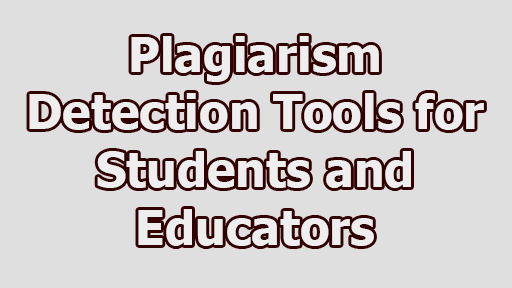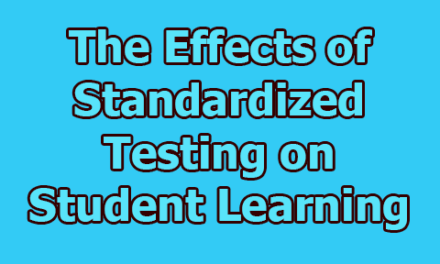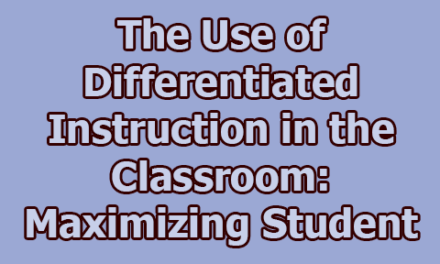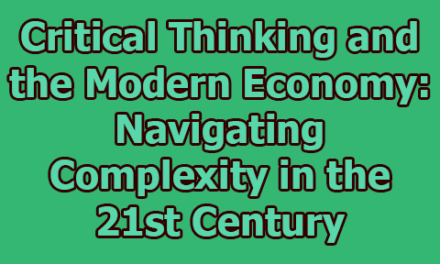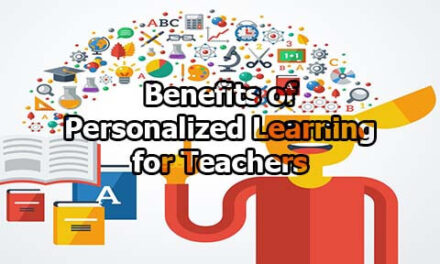Plagiarism Detection Tools for Students and Educators:
Plagiarism is a serious academic offense that involves the unauthorized use or reproduction of someone else’s work, ideas, or intellectual property without proper attribution. It undermines the integrity of the educational system and can have severe consequences for students and educators alike. To combat plagiarism, many educational institutions and individuals turn to plagiarism detection tools. In this article, we will explore the use of plagiarism detection tools for students and educators.
Plagiarism Detection Tools for Students:
1. Understanding Plagiarism: Before delving into the world of plagiarism detection tools, it’s imperative for students to have a comprehensive grasp of what constitutes plagiarism. Plagiarism encompasses various forms, including verbatim copying without proper citation, inadequate paraphrasing, and submitting someone else’s work as one’s own (Roig, 2016). Familiarity with these concepts is foundational for responsible academic writing.
2. Citation and Referencing: Proper citation and referencing are the cornerstones of plagiarism prevention (Purdue Online Writing Lab, n.d.). Students must become proficient in citation styles such as APA, MLA, Chicago, and others, based on the requirements of their academic discipline. Additionally, citation guides and reference management tools like Zotero or EndNote provide invaluable assistance in managing and citing sources accurately.
3. Plagiarism Detection Tools: Plagiarism detection tools are specialized software applications designed to identify similarities between a student’s work and existing sources (Hall & Rojewski, 2009). Popular tools include Turnitin, Grammarly, Copyscape, and Plagscan. Here’s an exploration of how students can utilize these tools effectively:
- Pre-submission Check: One of the primary uses of plagiarism detection tools is to conduct a pre-submission check. Before submitting assignments or research papers, students can upload their work to these tools to scan for potential issues (Weber-Wulff, 2014). This proactive approach allows students to rectify any unintentional plagiarism and ensure the integrity of their work.
- Self-Check for Paraphrasing: Plagiarism detection tools can also be valuable for self-checking. Students can employ these tools to identify instances of inadvertent plagiarism due to inadequate paraphrasing (Pecorari, 2003). This feature helps students recognize areas in their writing that require improvement, particularly in terms of paraphrasing and citation.
- Originality Reports: Some plagiarism detection tools generate comprehensive originality reports (Paltridge & Starfield, 2007). These reports provide a detailed breakdown of the similarities detected in the submitted work and external sources. Students can use these reports as a learning opportunity to enhance their writing and citation skills, making it a valuable tool for self-improvement.
4. Plagiarism Prevention: In addition to utilizing plagiarism detection tools, students should actively engage in plagiarism prevention strategies:
- Time Management: Procrastination often leads to rushed, poorly cited work. Effective time management is key to reducing the temptation to plagiarize (Steel, 2007). By planning their research and writing process carefully, students can allocate sufficient time for proper citation and paraphrasing.
- Understanding Sources: A deep understanding of sources is vital for proper paraphrasing and citation (Wachs, 2016). Students should take the time to thoroughly read and comprehend their sources, making it easier to integrate them seamlessly into their own work.
- Seeking Guidance: When uncertainty arises regarding proper citation or paraphrasing, students should not hesitate to seek guidance from their instructors or utilize academic support services (Howard, 2000). Instructors and librarians are valuable resources who can provide clarification and assistance.
Plagiarism detection tools are indispensable resources that empower students to uphold academic integrity while refining their research and writing skills. When coupled with proper education and guidance, these tools not only assist in plagiarism prevention but also contribute to the development of essential academic competencies. Striking a balance between detection and education is fundamental in fostering a culture of honesty and originality in the academic realm.
Plagiarism Detection Tools for Educators:
1. Integrating Tools Into Curriculum:
- Teaching Proper Citations: Educators have a vital role in educating students about proper citation practices (Pecorari, 2003). This entails incorporating lessons on citation styles such as APA, MLA, or Chicago into the curriculum. By instilling an understanding of citation conventions, educators empower students to give credit to original sources properly (Purdue Online Writing Lab, n.d.).
- Plagiarism Workshops: Plagiarism awareness workshops are invaluable tools for educators (Hall & Rojewski, 2009). These workshops offer a dedicated platform for discussing the nuances of academic integrity, the consequences of plagiarism, and strategies for avoiding it. Through interactive sessions, students gain a deeper understanding of ethical research and writing practices.
- Providing Access to Tools: Educational institutions can proactively support academic integrity by providing students with access to plagiarism detection tools (Weber-Wulff, 2014). By making these tools readily available, institutions reinforce the message that originality is paramount, and unethical practices will not be tolerated. This accessibility also encourages students to conduct self-checks on their work, promoting a culture of responsibility.
2. Identifying and Addressing Plagiarism:
- Detecting Plagiarism: Plagiarism detection tools serve as vigilant guardians of academic integrity (Hall & Rojewski, 2009). Educators can use these tools to scrutinize student submissions for instances of plagiarism. By uploading assignments, essays, or research papers, educators can accurately gauge the extent and severity of plagiarism in student work.
- Educational Approach: An educational approach to addressing plagiarism is highly effective (Roig, 2016). Rather than resorting exclusively to punitive measures, educators can engage in constructive dialogues with students who have committed plagiarism. These conversations offer opportunities to explain the ethical dimensions of plagiarism, provide guidance on proper research and citation, and offer students the chance to rectify their mistakes and learn from them.
- Feedback and Improvement: Effective feedback is a cornerstone of addressing plagiarism (Paltridge & Starfield, 2007). When educators detect plagiarism, they should provide detailed and constructive feedback to students. This feedback should not only highlight areas where plagiarism occurred but also offer guidance on how to correct and improve writing and citation practices. By nurturing improvement, educators facilitate a culture of continuous learning.
3. Policy Development:
- Communicating Policies: Educators and educational institutions should establish clear, well-communicated policies on academic integrity and plagiarism (Howard, 2000). These policies should be readily accessible to students and should outline the consequences of plagiarism. Communication is key to ensuring that students understand the expectations and consequences associated with academic integrity.
- Consistency: Consistency is vital in enforcing plagiarism policies (Hall & Rojewski, 2009). Educators should apply these policies consistently across all courses and assignments, ensuring fairness and equity. Consistency reinforces the importance of academic integrity and discourages unethical practices.
4. Encouraging Originality:
- Engaging Assignments: Educators can design assignments that actively encourage critical thinking and originality (Pecorari, 2003). These assignments should require students to delve deeply into course material, analyze it critically, and express their own unique perspectives. By creating tasks that demand independent thought, educators reduce the temptation for students to resort to plagiarism.
- Feedback and Support: Ongoing support and guidance from educators are essential in nurturing students’ research and writing skills (Paltridge & Starfield, 2007). Encouraging open lines of communication and offering assistance when needed empower students to develop their academic abilities. When students know they can turn to educators for guidance, they are less likely to resort to unethical practices like plagiarism.
Plagiarism detection tools are potent allies for educators in their mission to cultivate academic integrity and uphold the credibility of their educational institutions. When seamlessly integrated into an educational framework that includes clear policies, consistent enforcement, ethical guidance, and opportunities for learning, these tools not only assist in plagiarism prevention but also contribute significantly to the development of responsible, ethical, and original scholars. Ultimately, the goal is to create an educational environment where students value originality, critical thinking, and the ethical use of information.
In conclusion, plagiarism detection tools are valuable resources for both students and educators in promoting academic integrity. When used in conjunction with proper education and guidance, these tools can help students develop essential research and writing skills while ensuring the integrity of the academic environment. However, it’s crucial to strike a balance between detection and education to foster a culture of honesty and originality in academia.
References:
- Hall, C. J., & Rojewski, J. W. (2009). Cheating in academic institutions: A decade of research. Ethics & Behavior, 19(3), 227-250.
- Howard, R. M. (2000). A plagiarism pentimento. Journal of Teaching Writing, 19(1), 49-63.
- Paltridge, B., & Starfield, S. (2007). Thesis and dissertation writing in a second language: A handbook for supervisors. Routledge.
- Pecorari, D. (2003). Good and original: Plagiarism and patchwriting in academic second-language writing. Journal of Second Language Writing, 12(4), 317-345.
- Purdue Online Writing Lab. (n.d.). Research and Citation Resources. Purdue University.
- Roig, M. (2016). Plagiarism and paraphrasing criteria of college and university professors. Ethics & Behavior, 26(3), 223-234.
- Steel, P. (2007). The nature of procrastination: A meta-analytic and theoretical review of quintessential self-regulatory failure. Psychological Bulletin, 133(1), 65-94.
- Weber-Wulff, D. (2014). False feathers: A perspective on academic plagiarism. Journal of Academic Ethics, 12(4), 275-279.
- Wachs, S. (2016). What is in your library? An exploration of academic library collections. College & Research Libraries, 77(5), 595-603.

Assistant Teacher at Zinzira Pir Mohammad Pilot School and College

